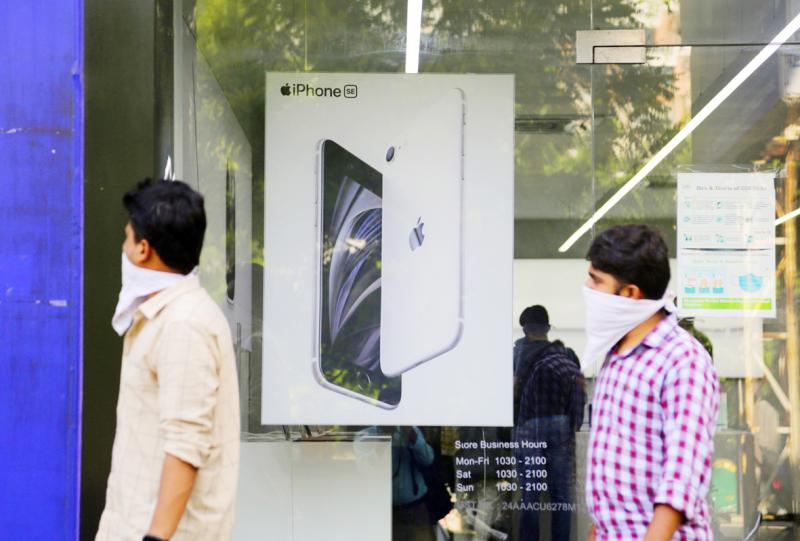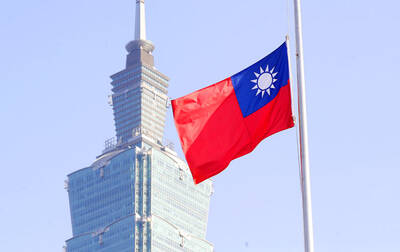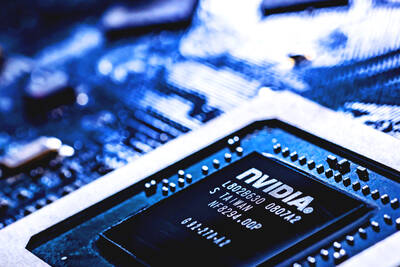An Apple Inc vendor is looking at shifting six production lines to India from China, which could result in US$5 billion of iPhone exports from the South Asian nation, the Times of India reported, citing people familiar with the matter who it did not identify.
The establishment of the facility would create about 55,000 jobs over about a year, the newspaper reported, not naming the Apple vendor.
It would also cater to the domestic market and expand operations to include tablets and laptops, the newspaper reported.

Photo: AP Photo/Ajit Solanki
Samsung Electronics Co and Apple’s assembly partners are among 22 companies that have pledged 110 billion rupees (US$1.47 billion) of investments to set up mobile phone manufacturing units in India.
Taiwan’s Foxconn Technology Group (富士康科技集團), Wistron Corp (緯創) and Pegatron Corp (和碩), all iPhone assemblers, are among companies picked to make smartphones under a production-linked incentive plan, Indian Minister of Electronics and Information Technology Ravi Shankar Prasad told a news conference in New Delhi on Saturday.
The move could boost the value of phone output to 11.5 trillion rupees in the next five years, he said.
The incentives are aimed at encouraging global companies to shift their manufacturing beyond China after a pandemic-induced trade dispute put the focus on risks to supply chains. The step is also part of Indian Prime Minister Narendra Modi’s calls for a self-reliant India aimed at boosting local manufacturing and reducing dependence on imports.
“The move is not against any country, but is India positive,” Prasad said.
The aim is for India to become a big global player in the electronics manufacturing segment, he said.
The plan is expected to generate 300,000 direct jobs and 900,000 indirect jobs in the next five years. Indian companies including Dixon Technologies and Optiemus Electronics have also applied to take advantage of the incentive program.
Companies that have submitted applications for component manufacturing include Ascent Circuits and Visicon, the government said in a statement.
As per the plan, the government is offering a financial incentive of as much as 6 percent on incremental sales of goods made in the country for five years.
It also promises that an incentive of 25 percent on capital expenditure would be provided for production of electronic components, semiconductors and other parts.

When Lika Megreladze was a child, life in her native western Georgian region of Guria revolved around tea. Her mother worked for decades as a scientist at the Soviet Union’s Institute of Tea and Subtropical Crops in the village of Anaseuli, Georgia, perfecting cultivation methods for a Georgian tea industry that supplied the bulk of the vast communist state’s brews. “When I was a child, this was only my mum’s workplace. Only later I realized that it was something big,” she said. Now, the institute lies abandoned. Yellowed papers are strewn around its decaying corridors, and a statue of Soviet founder Vladimir Lenin

UNIFYING OPPOSITION: Numerous companies have registered complaints over the potential levies, bringing together rival automakers in voicing their reservations US President Donald Trump is readying plans for industry-specific tariffs to kick in alongside his country-by-country duties in two weeks, ramping up his push to reshape the US’ standing in the global trading system by penalizing purchases from abroad. Administration officials could release details of Trump’s planned 50 percent duty on copper in the days before they are set to take effect on Friday next week, a person familiar with the matter said. That is the same date Trump’s “reciprocal” levies on products from more than 100 nations are slated to begin. Trump on Tuesday said that he is likely to impose tariffs

ELECTRONICS BOOST: A predicted surge in exports would likely be driven by ICT products, exports of which have soared 84.7 percent from a year earlier, DBS said DBS Bank Ltd (星展銀行) yesterday raised its GDP growth forecast for Taiwan this year to 4 percent from 3 percent, citing robust demand for artificial intelligence (AI)-related exports and accelerated shipment activity, which are expected to offset potential headwinds from US tariffs. “Our GDP growth forecast for 2025 is revised up to 4 percent from 3 percent to reflect front-loaded exports and strong AI demand,” Singapore-based DBS senior economist Ma Tieying (馬鐵英) said in an online briefing. Taiwan’s second-quarter performance beat expectations, with GDP growth likely surpassing 5 percent, driven by a 34.1 percent year-on-year increase in exports, Ma said, citing government

HELPING HAND: Approving the sale of H20s could give China the edge it needs to capture market share and become the global standard, a US representative said The US President Donald Trump administration’s decision allowing Nvidia Corp to resume shipments of its H20 artificial intelligence (AI) chips to China risks bolstering Beijing’s military capabilities and expanding its capacity to compete with the US, the head of the US House Select Committee on Strategic Competition Between the United States and the Chinese Communist Party said. “The H20, which is a cost-effective and powerful AI inference chip, far surpasses China’s indigenous capability and would therefore provide a substantial increase to China’s AI development,” committee chairman John Moolenaar, a Michigan Republican, said on Friday in a letter to US Secretary of